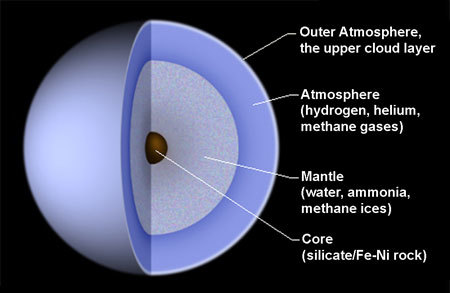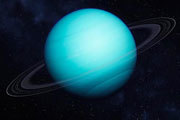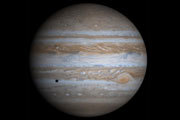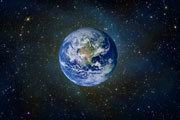Uranus is the seventh planet from the Sun and the third largest planet in our Solar System. Uranus was first discovered in 1781 by William Herschel, when he was testing out a new telescope. He named the planet Georgium Sidus (the Georgian star) after the English King, George III, but later the name was changed to Uranus because all the other planets have been named after Roman or Greek gods. Uranus, in Greek mythology means god of the Heavens. Uranus was the husband of Gaia, the goddess of Earth and father to Saturn.
Uranus - What It's All About!
Uranus is made up of mainly rock and ice and is a gas planet. It is made of 83 per cent hydrogen, 15 per cent helium and two per cent methane. Uranus' blue color comes from methane which absorbs red light in the atmosphere. Uranus' axis is different than any other planet in the Solar System. Instead of rotating upright like all the other planets, Uranus spins on a 98 degree axis. It's almost like a pig roasting on a fire. Uranus is hotter at its equator than at its poles. Funny thing is, Scientists don't even know which one is the north pole and which is the south pole.
 Diagram of the Interior of Uranus
Diagram of the Interior of Uranus
Uranus - Fun Facts
- Like Saturn, Jupiter and Neptune, Uranus also has rings. All of them are very faint and some of them are only half rings. The rings are made up of fine dust, rocks and ice boulders. It has at least 22 moons, Titania and Oberon being the largest.
- Like Venus, Uranus spins from east to west, which is opposite the direction Earth spins. This means you'd see the sun rise in the west and set in the east.
- A day on Uranus would be 17 hours and 14 minutes. A year would be 84 Earth years.
- Uranus is the first planet to be discovered in modern times.
- Voyager 2 is the only spacecraft to ever visit the planet which was back in 1986.
- German seismologist (someone who studies earthquakes) Rudolf Tomascheck found that strong earthquakes happen when Uranus is within 15 degrees of the meridian - a big imaginary circle around Earth's surface passing through the North and South geographic poles. In other words, the planet has some effect on Earth.
 Planet Overview - Uranus
Planet Overview - Uranus

































